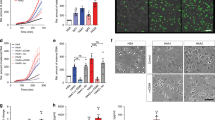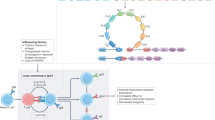Abstract
Immunoglobulin (Ig)-free light chains IgLC are present in serum and their production is augmented under pathological conditions such as multiple sclerosis, rheumatoid arthritis and neurological disorders. Until now, no (patho)physiological function has been ascribed to circulating Ig light chains. Here we show that IgLCs can confer mast cell–dependent hypersensitivity in mice. Antigenic stimulation results in plasma extravasation, cutaneous swelling and mast-cell degranulation. We show that IgLCs have a crucial role in development of contact sensitivity, which could be completely prevented by a novel IgLC antagonist. Although IgE and IgG1 are central to the induction of immediate hypersensitivity reactions, our results show that IgLCs have similar activity. IgLCs may therefore be a novel factor in the humoral immune response to antigen exposure. Our findings open new avenues in investigating the pathogenesis of autoimmune diseases and their treatments.
This is a preview of subscription content, access via your institution
Access options
Subscribe to this journal
Receive 12 print issues and online access
$209.00 per year
only $17.42 per issue
Buy this article
- Purchase on Springer Link
- Instant access to full article PDF
Prices may be subject to local taxes which are calculated during checkout






Similar content being viewed by others
References
Corry, D.B. & Kheradmand, F. Induction and regulation of the IgE response. Nature 402, B18–23 (1999).
Oettgen, H.C. et al. Active anaphylaxis in IgE-deficient mice. Nature 370, 367–370 (1994).
Miyajima, I. et al. Systemic anaphylaxis in the mouse can be mediated largely through IgG1 and Fc γRIII. Assessment of the cardiopulmonary changes, mast cell degranulation, and death associated with active or IgE- or IgG1-dependent passive anaphylaxis. J. Clin. Invest. 99, 901–914 (1997).
Van Loveren, H. et al. Immune serum from mice contact-sensitized with picryl chloride contains an antigen-specific T cell factor that transfers immediate cutaneous reactivity. Eur. J. Immunol. 16, 1203–1208 (1986).
Hopper, J.E. & Papagiannes, E. Evidence by radioimmunoassay that mitogen-activated human blood mononuclear cells secrete significant amounts of light chain Ig unassociated with heavy chain. Cell. Immunol. 101, 122–131 (1986).
Shapiro, A.L., Scharff, M.D., Maizel, J.V. & Uhr, J.W. Synthesis of excess light chains of γ globulin by rabbit lymph node cells. Nature 211, 243–245 (1966).
Skvortsov, V.T. & Gurvich, A.E. Relative rates of synthesis of immunoglobulins and light chains in rabbit spleen cells during secondary response. Nature 218, 377–378 (1968).
Hannam-Harris, A.C. & Smith, J.L. Free immunoglobulin light chain synthesis by human foetal liver and cord blood lymphocytes. Immunology 43, 417–423 (1981).
Waldmann, T.A., Strober, W. & Mogielnicki, R.P. The renal handling of low molecular weight proteins. II. Disorders of serum protein catabolism in patients with tubular proteinuria, the nephrotic syndrome, or uremia. J. Clin. Invest. 51, 2162–2174 (1972).
Yoo, T.J., Roholt, O.A. & Pressman, D. Specific binding activity of isolated light chains of antibodies. Science 157, 707–709 (1967).
Masat, L., Wabl, M. & Johnson, J.P. A simpler sort of antibody. Proc. Natl. Acad. Sci. USA 91, 893–896 (1994).
Sun, M., Li, L., Gao, Q.S. & Paul, S. Antigen recognition by an antibody light chain. J. Biol. Chem. 269, 734–738 (1994).
Ledbetter, J.A., Fell, H.P., Grosmaire, L.S., Norris, N.A. & Tsu, T.T. An immunoglobulin light chain dimer with CD4 antigen specificity. Mol. Immunol. 24, 1255–1261 (1987).
Schechter, I. & Ziv, E. Binding of 2,4-dinitrophenyl derivatives by the light chain dimer obtained from immunoglobulin A produced by MOPC-315 mouse myeloma. Biochemistry 15, 2785–2790 (1976).
Painter, R.G., Sage, H.J. & Tanford, C. Contributions of heavy and light chains of rabbit immunoglobulin G to antibody activity. I. Binding studies on isolated heavy and light chains. Biochemistry 11, 1327–1337 (1972).
Tribbick, G., Edmundson, A.B., Mason, T.J. & Geysen, H.M. Similar binding properties of peptide ligands for a human immunoglobulin and its light chain dimer. Mol. Immunol. 26, 625–635 (1989).
Thiagarajan, P. et al. Monoclonal antibody light chain with prothrombinase activity. Biochemistry 39, 6459–6465 (2000).
Sun, M., Gao, Q.S., Li, L. & Paul, S. Proteolytic activity of an antibody light chain. J. Immunol. 153, 5121–5126 (1994).
Kitamura, D., Roes, J., Kuhn, R. & Rajewsky, K. A B cell-deficient mouse by targeted disruption of the membrane exon of the immunoglobulin mu chain gene. Nature 350, 423–426 (1991).
Kalesnikoff, J. et al. Monomeric IgE stimulates signaling pathways in mast cells that lead to cytokine production and cell survival. Immunity 14, 801–811 (2001).
Asai, K. et al. Regulation of mast cell survival by IgE. Immunity 14, 791–800 (2001).
Yamaguchi, M. et al. IgE enhances mouse mast cell Fc(epsilon)RI expression in vitro and in vivo: Evidence for a novel amplification mechanism in IgE-dependent reactions. J. Exp. Med. 185, 663–672 (1997).
Hsu, C. & MacGlashan, D., Jr. IgE antibody up-regulates high affinity IgE binding on murine bone marrow-derived mast cells. Immunol. Lett. 52, 129–134 (1996).
Sheets, E.D., Holowka, D. & Baird, B. Critical role for cholesterol in Lyn-mediated tyrosine phosphorylation of FcepsilonRI and their association with detergent-resistant membranes. J. Cell. Biol. 145, 877–887 (1999).
Meade, R., Van Loveren, H., Parmentier, H., Iverson, G.M. & Askenase, P.W. The antigen-binding T cell factor PCl-F sensitizes mast cells for in vitro release of serotonin. Comparison with monoclonal IgE antibody. J. Immunol. 141, 2704–2713 (1988).
Huang, Z.Q. & Sanders, P.W. Localization of a single binding site for immunoglobulin light chains on human Tamm-Horsfall glycoprotein. J. Clin. Invest. 99, 732–736 (1997).
Tsuji, R.F. et al. Required early complement activation in contact sensitivity with generation of local C5-dependent chemotactic activity, and late T cell interferon γ: A possible initiating role of B cells. J. Exp. Med. 186, 1015–1026 (1997).
Takai, T., Li, M., Sylvestre, D., Clynes, R. & Ravetch, J.V. FcR γ chain deletion results in pleiotrophic effector cell defects. Cell 76, 519–529 (1994).
Maeda, A., Kurosaki, M. & Kurosaki, T. Paired immunoglobulin-like receptor (PIR)-A is involved in activating mast cells through its association with Fc receptor γ chain. J. Exp. Med. 188, 991–995 (1998).
Lee, K.H., Ono, M., Inui, M., Yuasa, T. & Takai, T. Stimulatory function of gp49A, a murine Ig-like receptor, in rat basophilic leukemia cells. J. Immunol. 165, 4970–4977 (2000).
Pirozzi, G., Terry, R.W., Epstein, D. & Labow, M.A. Identification and characterization of a novel surface antigen gene induced in mast cells activated through the high affinity IgE receptor. J. Immunol. 155, 5811–5818 (1995).
Smith, D.A., Monk, P.N. & Partridge, L.J. Antibodies against human CD63 activate transfected rat basophilic leukemia (RBL-2H3) cells. Mol. Immunol. 32, 1339–1344 (1995).
Echtenacher, B., Mannel, D.N. & Hultner, L. Critical protective role of mast cells in a model of acute septic peritonitis. Nature 381, 75–77 (1996).
Biedermann, T. et al. Mast cells control neutrophil recruitment during T cell-mediated delayed-type hypersensitivity reactions through tumor necrosis factor and macrophage inflammatory protein 2. J. Exp. Med. 192, 1441–1452 (2000).
Secor, V.H., Secor, W.E., Gutekunst, C.A. & Brown, M.A. Mast cells are essential for early onset and severe disease in a murine model of multiple sclerosis. J. Exp. Med. 191, 813–822 (2000).
Woolley, D.E. & Tetlow, L.C. Mast cell activation and its relation to proinflammatory cytokine production in the rheumatoid lesion. Arthritis Res. 2, 65–74 (2000).
Geba, G.P. et al. Delayed-type hypersensitivity in mast cell-deficient mice: Dependence on platelets for expression of contact sensitivity. J. Immunol. 157, 557–565 (1996).
Askenase, P.W. & Tsuji, R.F. B-1 B cell IgM antibody initiates T cell elicitation of contact sensitivity. Curr. Top. Microbiol. Immunol. 252, 171–177 (2000).
Fagnart, O.C., Sindic, C.J. & Laterre, C. Free κ and λ light chain levels in the cerebrospinal fluid of patients with multiple sclerosis and other neurological diseases. J. Neuroimmunol. 19, 119–132 (1988).
Moutsopoulos, H.M., Steinberg, A.D., Fauci, A.S., Lane, H.C. & Papadopoulos, N.M. High incidence of free monoclonal λ light chains in the sera of patients with Sjogren's syndrome. J. Immunol. 130, 2663–2665 (1983).
Solling, K., Solling, J. & Romer, F.K. Free light chains of immunoglobulins in serum from patients with rheumatoid arthritis, sarcoidosis, chronic infections and pulmonary cancer. Acta Med. Scand. 209, 473–477 (1981).
Rozniecki, J.J., Hauser, S.L., Stein, M., Lincoln, R. & Theoharides, T.C. Elevated mast cell tryptase in cerebrospinal fluid of multiple sclerosis patients. Ann. Neurol. 37, 63–66 (1995).
Marone, G. Mast cells in rheumatic disorders: Mastermind or workhorse? Clin. Exp. Rheumatol. 16, 245–249 (1998).
Karimi, K., Redegeld, F.A., Heijdra, B. & Nijkamp, F.P. Stem cell factor and interleukin-4 induce murine bone marrow cells to develop into mast cells with connective tissue type characteristics in vitro. Exp. Hematol. 27, 654–662 (1999).
Lukacs, N.W. et al. The role of stem cell factor (c-kit ligand) and inflammatory cytokines in pulmonary mast cell activation. Blood 87, 2262–2268 (1996).
Acknowledgements
We thank C. Beukelman for his initial help with the high performance gel filtration experiments; C. Vallinga, D. Kegler, P. van Schaaik, S. de Jager, A. van Houwelingen and B. Blokhuis for expert technical assistance; C. Burger for performing the electron microscopy studies; C. Milstein for providing the oxazolone-specific antibody producing hybridoma; H. Metzger and N. Bloksma for helpful suggestions and critical reading of the manuscript; A. Dvorak for evaluation and discussion of the electron microscopical studies. This work was supported by grants from the Royal Dutch Academy of Arts and Sciences, GlaxoSmithKline, the Netherlands and Fornix Biosciences, the Netherlands.
Author information
Authors and Affiliations
Corresponding author
Ethics declarations
Competing interests
This research is being sponsored in part by Fornix Biosciences, Lelystad, the Netherlands.
Rights and permissions
About this article
Cite this article
Redegeld, F., van der Heijden, M., Kool, M. et al. Immunoglobulin-free light chains elicit immediate hypersensitivity-like responses. Nat Med 8, 694–701 (2002). https://doi.org/10.1038/nm722
Received:
Accepted:
Published:
Issue Date:
DOI: https://doi.org/10.1038/nm722
This article is cited by
-
Free immunoglobulin light chain (FLC) promotes murine colitis and colitis-associated colon carcinogenesis by activating the inflammasome
Scientific Reports (2017)
-
Proteomic analysis of plasma after branched chain enriched mixture supplementation in mice
Journal of the International Society of Sports Nutrition (2013)
-
Mucosal Immune Cell Numbers and Visceral Sensitivity in Patients With Irritable Bowel Syndrome: Is There Any Relationship?
American Journal of Gastroenterology (2012)



